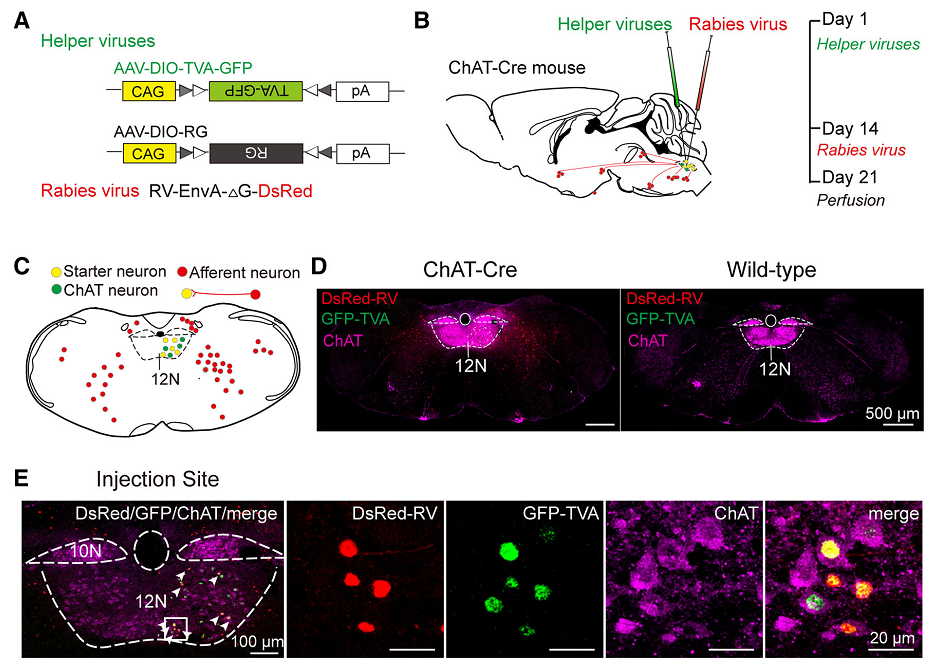AAVs of tracing helper and RV were used for retrograde monosynaptic tracing. (From
BrainVTA)
The viruses used from BrainVTA in this article are in the table below
|
Tracing Helper |
AAV2/9-CAG-DIO-TVA-GFP
PT-0519 AAV2/9-CAG-DIO-RG |
|
RV |
R01002 RV-EnvA-DG-DsRed |
Han Guo, Xiang-Shan Yuan, Ji-Chuan Zhou, Hui Chen, Shan-Qun Li, Wei-Min Qu, Zhi-Li Huang
Pub Date: 2020-02-24,
DOI: 10.1007/s12264-020-00468-9,
Email: sales@brainvta.com
Hypoglossal motor neurons (HMNs) innervate tongue muscles and play key roles in a variety of physiological functions, including swallowing, mastication, suckling, vocalization, and respiration. Dysfunction of HMNs is associated with several diseases, such as obstructive sleep apnea (OSA) and sudden infant death syndrome. OSA is a serious breathing disorder associated with the activity of HMNs during different sleep–wake states. Identifying the neural mechanisms by which the state-dependent activities of HMNs are controlled may be helpful in providing a theoretical basis for effective therapy for OSA. However, the presynaptic partners governing the activity of HMNs remain to be elucidated. In the present study, we used a cell-type-specific retrograde tracing system based on a modified rabies virus along with a Cre/loxP gene-expression strategy to map the whole-brain monosynaptic inputs to HMNs in mice. We identified 53 nuclei targeting HMNs from six brain regions: the amygdala, hypothalamus, midbrain, pons, medulla, and cerebellum. We discovered that GABAergic neurons in the central amygdaloid nucleus, as well as calretinin neurons in the parasubthalamic nucleus, sent monosynaptic projections to HMNs. In addition, HMNs received direct inputs from several regions associated with respiration, such as the pre-Botzinger complex, parabrachial nucleus, nucleus of the solitary tract, and hypothalamus. Some regions engaged in sleep–wake regulation (the parafacial zone, parabrachial nucleus, ventral medulla, sublaterodorsal tegmental nucleus, dorsal raphe nucleus, periaqueductal gray, and hypothalamus) also provided primary inputs to HMNs. These results contribute to further elucidating the neural circuits underlying disorders caused by the dysfunction of HMNs

Figure 1. Experimental system based on trans-synaptic rabies virus tracing to identify monosynaptic inputs to HMNs.
This study is aimed to identify the whole-brain inputs to Hypoglossal motor neurons (HMNs). Combining a genetically modified rabies virus for trans-synaptic retrograde tracing with the Cre/loxP gene expression system to comprehensively identify the monosynaptic inputs onto HMNs from the entire brain. The results contribute to further elucidating the neural circuits underlying disorders caused by the dysfunction of HMNs.
BrainVTA offers viral vector construction & virus packaging services for AAV, LV, RABV, PRV, HSV and VSV that help researchers explore questions about genes, neurons, circuitry structure, function of brain network, mechanism and treatment of diseases.
If you have any needs, just email us at
sales@brainvta.com.
